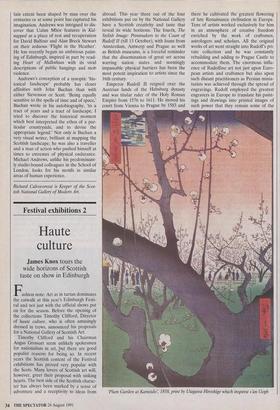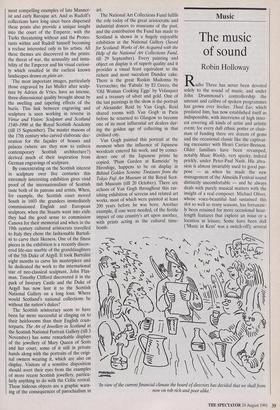Festival exhibitions 2
Haute culture
James Knox tours the wide horizons of Scottish taste on show in Edinburgh
ashion note: Art as in tartan dominates the catwalk at this year's Edinburgh Festi- val and not just with the official shows put on for the season. Before the opening of the collections Timothy Clifford, Director of haute culture, who is often amusingly dressed in trews, announced his proposals for a National Gallery of Scottish Art.
Timothy Clifford and his Chairman Angus Grossart seem unlikely spokesmen for nationalism in art, but there are good populist reasons for being so. In recent years the Scottish content of the Festival exhibitions has proved very popular with the Scots. Many lovers of Scottish art will, however, greet their proposal with sinking hearts. The best side of the Scottish charac- ter has always been marked by a sense of adventure and a receptivity to ideas from
abroad. This year three out of the four exhibitions put on by the National Gallery have a Scottish creativity and taste that reveal its wide horizons. The fourth, The Stylish Image: Printmakers to the Court of Rudolf II (till 13 October), with loans from Amsterdam, Antwerp and Prague as well as British museums, is a forceful reminder that the dissemination of great art across warring nation states and seemingly impassable physical barriers has been the most potent inspiration to artists since the
16th century. • Emperor Rudolf II reigned over the Austrian lands of the Habsburg dynasty and was titular ruler of the Holy Roman Empire from 1576 to 1611. He moved his court from Vienna to Prague by 1583 and there he cultivated the greatest flowering of late Renaissance civilisation in Europe. Tens of artists worked exclusively for him in an atmosphere of creative freedom enriched by the work of craftsmen, astrologers and scholars. All the original works of art went straight into Rudolf s pri- vate collection and he was constantly rebuilding and adding to Prague Castle to accommodate them. The enormous influ- ence of Rudolfine art not just upon Euro- pean artists and craftsmen but also upon such distant practitioners as Persian minia- turists was achieved through the spread of engravings. Rudolf employed the greatest engravers in Europe to translate his paint- ings and drawings into printed images of such power that they remain some of the 'Plum Garden at Kameido', 1858, print by Utagawa Hiroshige which inspired ✓an Gogh
most compelling examples of late Manner- ist and early Baroque art. And as Rudolf s collections have long since been dispersed these prints also provide a unique insight into the court of the Emperor, with the Turks threatening without and the Protes- tants within and Rudolf himself becoming a recluse interested only in his artists. All these themes are discovered in the prints: the threat of war, the sensuality and insta- bility of the Emperor and his visual curiosi- ty which resulted in the earliest known landscapes drawn en plein air.
The most important images, particularly those engraved by Jan Muller after sculp- ture by Adrien de Vries, have an intense, three-dimensional quality brought about by the swelling and tapering effects of the burin. This link between engraving and sculpture is seen working in reverse in Virtue and Vision: Sculpture and Scotland 1540-1990 at the Royal Scottish Academy (till 15 September). The master masons of the 17th century who carved elaborate dec- oration for the façades of houses and palaces (where are they now to enliven contemporary Scottish architecture?) derived much of their inspiration from German engravings of sculpture.
By concentrating on the Scottish interest in sculpture over five centuries this extremely interesting exhibition gives vivid proof of the internationalism of Scottish taste both of its patrons and artists. When, for example, the Scottish court moved South in 1603 the grandees immediately commissioned English and European sculptors; when the Stuarts went into exile they had the good sense to commission Canova for their memorial and when in the 19th century cultured aristocrats travelled to Italy they chose the fashionable Bartoli- ni to carve their likeness. One of the finest pieces in the exhibition is a recently discov- ered life-size marble of the granddaughters of the 5th Duke of Argyll. It took Bartolini eight months to carve his masterpiece and he dedicated the work to the international star of neo-classical sculpture, John Flax- man. Timothy Clifford discovered it in the park of Inverary Castle and the Duke of Argyll has now lent it to the Scottish National Gallery on a long loan. Where would Scotland's national collections be without the nation's dukes?
The Scottish aristocracy seem to have been far more successful at clinging on to their heirl000ms than their English coun- terparts. The Art of Jewellery in Scotland at the Scottish National Portrait Gallery (till 3 November) has some remarkable displays of the jewellery of Mary Queen of Scots and her court, some of it still in private hands along with the portraits of the origi- nal owners wearing it, which are also on display. Visitors of a sensitive disposition should avert their eyes from the examples of more recent Scottish jewellery, particu- larly anything to do with the Celtic revival. These hideous objects are a graphic warn- ing of the consequences of parochialism in
art.
The National Art Collections Fund fulfils the role today of the great aristocratic and industrial donors to museums of the past, and the contribution the Fund has made to Scotland is shown in a hugely enjoyable exhibition at the National Gallery (Saved for Scotland: Works of Art Acquired with the Help of the National Art Collections Fund, till 29 September). Every painting and object on display is of superb quality and it provides a visual feast equivalent to the richest and most succulent Dundee cake. There is the great Ruskin Madonna by Verrocchio, the Tabula' by El Greco, the `Old Woman Cooking Eggs' by Velasquez and a treasury of silver and gold. One of the last paintings in the show is the portrait of Alexander Reid by Van Gogh. Reid shared rooms with Van Gogh in Paris before he returned to Glasgow to become one of its most influential art dealers dur- ing the golden age of collecting in that civilised city.
Van Gogh painted this portrait at the moment when the influence of Japanese woodcuts entered his work, and by coinci- dence one of the Japanese prints he copied, `Plum Garden at Kameido' by Hiroshige, happens to be on display in Behind Golden Screens: Treasures from the Tokyo Fuji Art Museum at the Royal Scot- tish Museum (till 20 October). There are echoes of Van Gogh throughout this rav- ishing exhibition of screens and related art works, most of which were painted at least 200 years before he was born. Another example, if one were needed, of the fertile impact of one country's art upon another, with prints acting as the cultural time- bomb.



















































 Previous page
Previous page